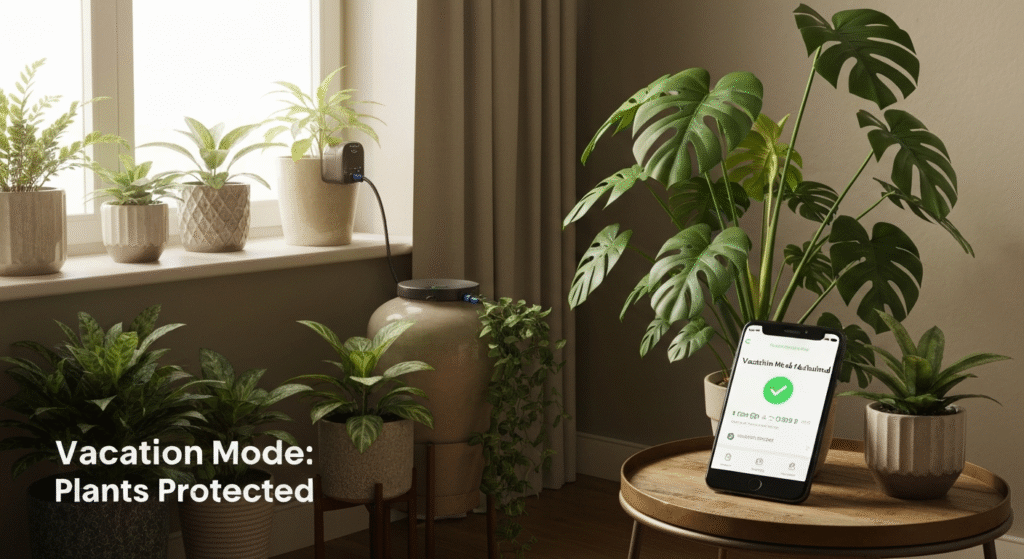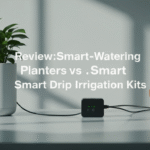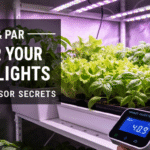Going on vacation should be relaxing. But for an indoor gardener, the days leading up to a trip can be filled with “plant anxiety.” Will they survive? Will I come home to a crispy, brown graveyard? We’ve all been there: trying to calculate the exact right amount of water, begging a neighbor (who doesn’t know a Pothos from a Philodendron) to check in, or crowding plants in the bathtub. These old methods are stressful and unreliable, especially for a full two-week trip.
The good news is that smart home automation has solved this problem. Smart watering setups give you precision, control, and, most importantly, peace of mind.
Hi, I’m Priya. My journey into smart gardening started about five years ago, not as a professional, but as a frustrated plant owner with a demanding job. I was tired of coming home from work trips to find my beloved Calathea completely wilted or my succulents rotted from a well-meaning friend’s “help.” My curiosity led me down a rabbit hole of testing dozens of smart home gadgets, and I’ve spent these past few years focused on one thing: finding what actually works for indoor gardeners. My goal is to share what I’ve learned through all that trial and error, so you can skip the frustration and get right to a thriving indoor garden.
Why “Smart” Watering Beats Old-School Methods for Vacations
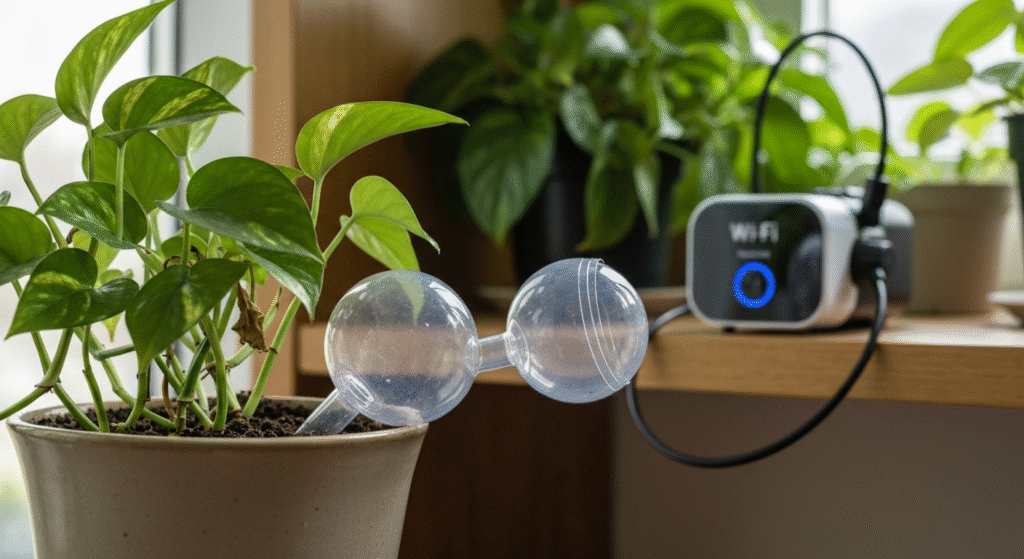
Before we get into the tech, let’s talk about why the old ways fail us, especially for a 14-day trip.
- The “Good Soak”: This only works for a few days, max. For two weeks, you’re guaranteeing your plants will be bone-dry by the time you return.
- Watering Globes: In my experience, these are wildly inconsistent. They either get clogged with soil and release no water, or they dump all their water in the first two days, leaving the plant waterlogged and then dry.
- The “Rely on a Friend” Method: This is a big ask. Your friend might forget, or worse, overwater. I once had a neighbor “helpfully” water my entire succulent collection every single day for a week. It was a disaster.
A smart watering system solves these problems. It’s not just “set it and forget it”; it’s “set it, monitor it, and trust it.” These systems use timers, apps, and precise delivery methods to give your plants exactly what they need to survive while you’re away. The goal isn’t peak growth; it’s healthy maintenance.
The Two Main Types of Smart Setups I’ve Tested
After setting up systems for my own collection (which is now over 50 plants), I’ve found that most vacation-proof setups fall into two categories. Which one you choose depends on your budget, the number of plants you have, and how much setup you’re willing to do.
Category 1: Wi-Fi Drip Irrigation Systems (The “Central Hub”)
This is the system I rely on for the majority of my plants. It’s the most flexible and cost-effective solution for anyone with more than 5-10 plants.
How it works: A small, Wi-Fi-enabled pump sits in a large water reservoir (I just use a 5-gallon bucket). A main tube runs from the pump, and you attach smaller “feeder” tubes that end in adjustable drippers. You stick one dripper in each plant pot. Using an app on your phone, you set a schedule: for example, “run the pump for 30 seconds every 3 days.”
This setup is a true game-changer. My main plant shelf is entirely hooked up to one of these systems. The pump and bucket are hidden away in a cabinet, and the thin black tubing is easy to hide behind pots.
My Personal Take on Wi-Fi Drip Systems
This is just my personal experience, and your results might be different depending on the brand you buy and your home’s humidity.
| Aspect | My Hands-On Experience |
| Setup | The first time, it took me about an hour. You have to cut the tubing to the right lengths and position all the drippers. It’s not “plug and play,” but it’s a one-time setup. |
| Pros | – Waters tons of plants (some kits support 15-20) from one source. – Highly customizable schedule via the app. – You can check the app from the beach and see that the schedule ran. – Very low cost per plant. |
| Cons | – The tubes can be a bit of an eyesore if you don’t take time to hide them. – You must have a large water reservoir for a 2-week trip. – All plants get watered on the same schedule (though you can adjust individual dripper flow). |
| Best For | Plant owners with a large collection (10+ plants) clustered in one or two areas. |
Category 2: Smart Self-Watering Planters (The “All-in-One”)
These are the “luxury” option. Instead of a central system, each plant gets its own smart pot. These planters have a built-in water reservoir in the base and a sensor that monitors the soil moisture.
How it works: You pot your plant directly into the smart planter. You fill the reservoir (which is often large enough to last weeks) and connect the planter to its app. The planter then wicks water up to the roots only when the soil sensor detects it’s dry.
I use these for my two largest, most expensive “diva” plants: a Fiddle Leaf Fig and a large Monstera. These plants are finicky and sit in different rooms, so a central drip system wasn’t practical. The smart planter gives them individual, high-tech care.
Pros of Smart Planters:
- Extremely Precise: This is the biggest benefit. The plant takes exactly what it needs, when it needs it. It’s almost impossible to over- or under-water.
- Clean Look: There are no tubes, pumps, or buckets. It just looks like a stylish, modern planter.
- Plant-Specific Data: The apps often tell you moisture level, light level, and even fertilizer reminders.
Cons of Smart Planters:
- Cost: They are very expensive on a per-plant basis. Outfitting a whole collection this way would cost a fortune.
- Repotting: You have to repot your plant into the smart planter, which can be a hassle.
- Multiple Apps: If you buy from different brands, you’ll have 5 different apps to manage 5 different plants.
Setting Up Your System for a 2-Week Trip: My Step-by-Step Guide
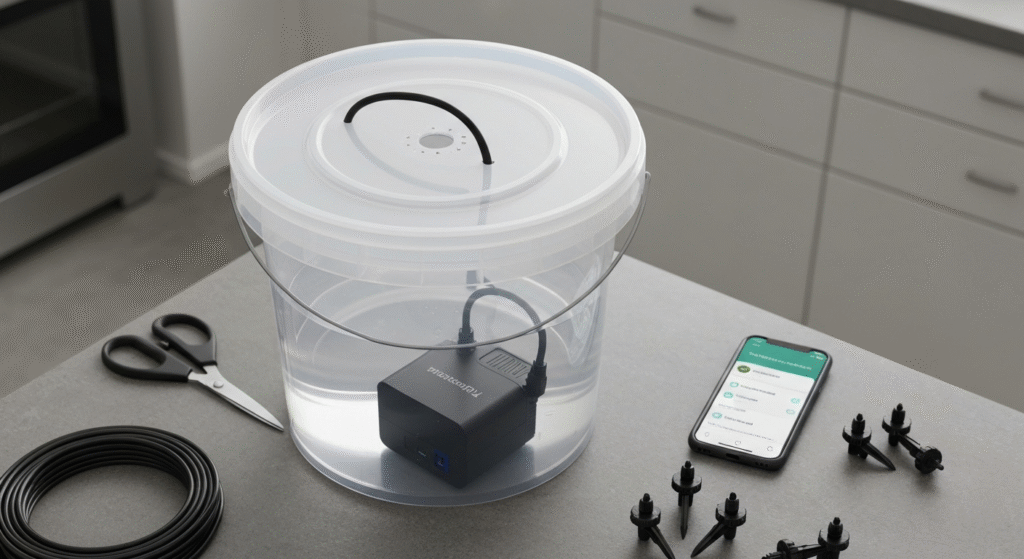
Buying the system is the easy part. The setup and testing are what will give you true peace of mind. Here is the exact process I follow before any vacation.
Step 1: Choose Your Water Source (Bigger is Better)
This is my #1 tip for a 2-week trip. A small bottle of water will not be enough. For my Wi-Fi drip system that waters about 15 plants, I use a 5-gallon (about 19-liter) bucket with a lid. I learned this the hard way on a 10-day trip where my 1-gallon reservoir ran dry on day 8.
- Why the lid? It prevents water from evaporating and stops dust or (in my case) pet hair from falling in and clogging the pump. I just drill a small hole in the lid for the pump’s power cord and the main water tube.
- How much water? This depends on your plants, but 5 gallons is a very safe bet for 15-20 mixed plants for two weeks, especially on a reduced schedule.
Step 2: The “Test Run” is Not Optional
Please, please do this. Set up your entire system at least one week before you leave. Do not set it up the night before you fly out. You need time to see how it works in the real world.
My first-ever test run was a mess. I set the timer for 2 minutes, thinking it was a short time. I came back an hour later to find my Pothos sitting in a flooded saucer, while the dripper for my cactus (at the end of the line) had barely let out a drop.
Run the system on the exact schedule you plan to use for your trip. After 2-3 days, check your plants.
- Is the soil too wet? Shorten the watering duration.
- Is the soil still dry? Increase the duration or adjust the dripper knob.
- How much water was actually used from your main reservoir? This helps you confirm your 5-gallon bucket is big enough.
Step 3: Programming the Schedule (Don’t Overdo It)
You are not trying to get your plants to produce new leaves while you’re gone. You are helping them survive. When I’m away, I reduce my watering schedule to about 60-70% of normal.
Why? The plants won’t be using as much water. You’ve likely moved them away from bright, hot windows (which you should do!). Less light = less photosynthesis = less water needed. This reduced schedule keeps the soil lightly moist without risking the dreaded root rot, which is a far greater danger than a little wilting.
My Typical 2-Week Vacation Schedule (for a Drip System):
- Program: Run
- Duration: 30 seconds
- Frequency: Every 3 days
This gives all my plants a small, consistent sip of water, and it’s been the sweet spot for me.
Step 4: Placing the Drippers and Checking Flow
Make sure each dripper is securely staked into the soil. You don’t want one to pop out and spend two weeks watering your hardwood floor.
Also, check the water pressure. The drippers closest to the pump will have the strongest flow. The drippers at the very end of the line will have the weakest. This is why most drippers are adjustable. I open the knobs wider for the plants at the far end of the tube and keep them narrower for the plants closest to the pump. This helps ensure everyone gets a similar amount of water.
What Can Go Wrong? (And How to Fix It)
After five years, I’ve had a few “oh no” moments. Here’s what I’ve learned to anticipate.
Problem: The Wi-Fi Goes Out
This was my biggest fear. I was on a weekend trip when my home internet went down. I panicked, thinking my plants were now stranded.
- The Fix: I was thrilled to discover that most modern Wi-Fi pumps (like the RainPoint and Moistenland models) save the schedule locally on the device itself. This means that even if the Wi-Fi dies, the pump will still run its programmed schedule. The only thing you lose is the ability to get app notifications or make changes remotely. This feature is a massive stress-reducer.
Problem: The Water Reservoir Runs Dry
This happens if you miscalculate or if your “test run” wasn’t long enough.
- The Fix: This is all about prevention. Use a bigger reservoir than you think you need. A 5-gallon bucket is my standard for a 2-week trip. If you are extremely worried, use two separate, smaller systems. Split your plants between two 2.5-gallon reservoirs. This creates redundancy—if one fails or runs dry, you only risk half your plants.
Problem: Clogged Drippers
This can happen if you use tap water with high mineral content, or if debris gets into your reservoir.
- The Fix: Two things. First, I try to use filtered water in my reservoir. This avoids mineral buildup (it’s better for the plants, too). Second, right before I lock my door to leave, I run the system on “Manual” mode for 60 seconds. This high-pressure flush clears any small bits of soil or dust from the lines and confirms one last time that all drippers are working.
Are Non-Smart Alternatives Ever Okay?
What about those simple watering wicks or globes? Honestly, for a 2-week trip, they make me too nervous. They are “set it and hope” devices. There’s no feedback, no control, and a high failure rate.
However, they can be a great supplement. For a very thirsty plant, like a large fern, I might use a smart dripper and add a large watering globe as a “backup” reservoir.
For more information on these low-tech methods, I’ve found guides from university agricultural extensions to be very reliable. For example, this vacation plant care guide from the University of Maryland Extension offers some great, simple advice for short-term trips. But for two weeks, I’m sticking with smart tech.
My Personal Checklist Before I Lock the Door
Here’s what I physically check right before I leave for the airport.
- Reservoir: Is it full to the top? Is the lid secure?
- Pump: Is it plugged in and connected to Wi-Fi? (Is the “online” light on?)
- App: Open the app. Does it show “Online”? Is the vacation schedule enabled?
- Tubes: Are all tubes pushed firmly into the pump and drippers?
- Drippers: Are all dripper stakes firmly in the soil, not pointing at the floor?
- Final Flush: Run the “Manual” water function for 30-60 seconds. Watch every single dripper to ensure water is coming out.
Frequently Asked Questions (FAQs)
How much water do I really need for a 2-week trip?
This heavily depends on your plants, pot size, and home environment. My best advice is to run your test schedule for 3 days, measure how much water was used, and then multiply that by 5 (for a 15-day-long trip, just to be safe). It’s always, always better to have too much water in the reservoir than too little.
Can these smart systems run on batteries?
Yes! Many of the most popular Wi-Fi drip pumps can be powered by either a USB wall plug or 4 AA batteries. I always use the wall plug for reliability, but I also install the batteries as a backup. If the power goes out, the batteries will take over and keep the schedule running.
What if I only have one or two plants?
Don’t buy a 20-plant drip system. For just one or two plants, a single smart self-watering planter is by far the easiest and most reliable solution. The other option is a very simple “plant-sitter” pump that just uses a USB-powered pump and a bottle, but I find the smart planters are more foolproof.
Will a smart system cause root rot?
It absolutely can if you program it incorrectly. This is why the test run is so important. Root rot comes from soil that is constantly wet. Your goal is not to keep the soil soggy, but to let it almost dry out and then give it a small, controlled drink. My “30 seconds every 3 days” schedule is designed specifically to avoid this.
My Final Thoughts
Coming home from a vacation is already a drag. Coming home to a house full of dead plants is just heartbreaking. It took me a few years of testing and a few failures to get my system right, but the peace of mind is now total.
Investing in a smart watering system—whether it’s a central drip kit or a few smart planters—is one of the best things you can do for your indoor garden and your own sanity. You can finally enjoy your time away, knowing that your green roommates are being cared for, watered, and will be healthy and happy when you return.
